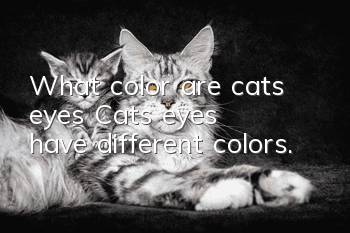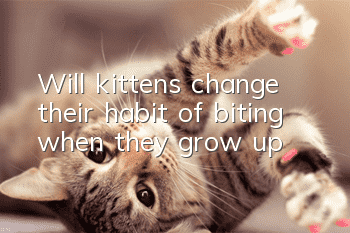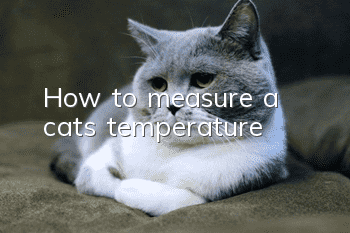What color are cats’ eyes? Cats’ eyes have different colors.

Domestic cats’ eye colors vary widely, including blue, green, yellow, orange and brown. Each color here has a hue variation from light to dark. These color transitions are not discontinuous but continuous.
How do the eyes appear color
There are two main reasons for feline eye color. Iris pigmentation and blue light reflectance.
The pigmentation of the iris is caused by melanin, and the color ranges from lemon yellow to light brown to dark orange or brown. In addition, the "transparent" eye structure, the lens, also reflects external light like a piece of glass. If you look at it from the front, the glass has no color, but if we slowly move the angle, you will see that it is green or blue. Likewise, the transparent structures of feline eyes are transparent blue, ranging in shades from colorless to very dark or violet-like blue. This combination of blue light reflected colors and the colors produced by iris pigmentation make up all cat eye colors.
Iris pigmentation and transparent structural pigment are controlled by multiple polygenes located at different locations on the chromosome. Kittens in a litter inherit a mixture of these polygenes from their parents and produce different eye colors. Different polygene mixtures result in arrangements of shades of color.
When kittens are born, they all have blue eyes. The eye color of an adult cat is fixed when it is six or seven weeks old, but it may not be fixed until it is three or four months old. Disease and injury can cause changes in eye color throughout a cat's life, but it is nonsense to say that feeding fish to a cat will cause the cat's eyes to change color. This is because when a cat is weaned, people Feeding fish to kittens. Before the advent of commercial cat food, everyone probably fed fish to kittens. However, this is exactly when the color of kittens’ eyes changes.
Blue Series
Kittens are born with blue eyes, but this is not their eye color that remains unchanged throughout their lives. In a few breeds, blue eyes will never change, but in most breeds, they will remain blue throughout their lives. It will be replaced by another color after six weeks. The shade of blue depends on how strongly blue light is reflected.
Blue eyes are a characteristic of point-colored cats, whose eye color is associated with albinism, which produces the point-colored pattern. The change in the hue and brightness of blue eyes requires breeders to selectively breed cats with the best eye color in this breed, so as to produce more ideal blue-eyed point color kittens.
Blue eyes also occur in pure white cats or cats that have a combination of the dominant pure white gene. But thisThe situation is completely different from that of albinism. Because the white dominant gene only covers the potential color of the body. If white spots appear around the eyes, they will affect eye pigments. White cats may have one or both blue eyes. White cats with non-blue eyes can have any color within the breed standard.
For example: A white Persian cat with a single blue eye has a brilliant orange eye color. The non-blue eye color in any white cat with mandarin duck eyes can be green or yellow or even a slight shade of blue.
Ojos Azules, Spanish for blue eyes, is a new cat breed with blue eyes, but not point color and not pure white - the translation is classified as cornflower blue, light blue eyes, but this mutation Linked to the fatal disability factor. If a kitten gets two copies of this mutated gene on both XY or XX chromosomes. Eye color has nothing to do with coat color in this breed. Other sudden blue eye mutations are also independent of coat color.
Green and light green
Greens range from yellowish green to gooseberry green to deeper greens and bluish-toned greens. Some older standards call it grass-green eyes, which means very, very green. Green colors or green spots sometimes appear in light brown or brown eyes.
Chinchillas and their short-haired cousins, the Exotics, are notable for their dark green eyes with black liner. The light blue-green color is found in the Tonkinese cat's eyes, and its body shape and color/pattern are somewhere between a Siamese cat and a Burmese cat. Siamese cats have blue eyes while Burmese cats have orange eyes.
Yellow, Orange/Amber and Brown
The yellow family ranges from pale lemon to more vibrant shades. This overlap also occurs between yellow and brown, hazel or tan, and between yellow and green.
The line between yellow and green may not be clear, but you won’t be mistaken for a cat with orange eyes. Orange eyes are often described as copper-colored. Much of the breed's development is due to the efforts of early British cat enthusiasts, who called it orange because yellow and light green cannot be defined, and bright orange also appears in the coat color.
Brown encompasses a wide range, from hazel, the normal eye color of wild white cats, to dark brown. Some brown eyes may have greenish-yellow or orange tints or spots.
Mandarin duck eyes~heterochromia
Among cats, mandarin duck eyes means that one eye is blue and the other eye is another color.
Mandarin duck eyes are the most commonAlbino-dominant cats have one eye that is blue and the other eye that is yellow, orange-brown, or green.
Pedigree cats have one blue eye and one orange/amber eye, but in casual breeding the non-blue eye may be yellow, green or brown. Some white cats have two blue eyes, but when photographed the flash causes one eye to reflect green and the other eye to reflect red. This is due to the different structure of the eyes. Highly white bicolor cats may also reflect mandarin duck eyes when photographed from the front.
Less common, cats of other colors also have mandarin duck eyes. For example: a tortoiseshell has one yellow eye and one blue eye. This is because the eyes develop differently during the embryonic stage. Maybe the cat has the gene for white spots, but it may not show up in the coat color and affect the eyes.
Sometimes different eye colors are caused by eye injury or disease. These causes damage to the iris or an eye. In this case, the trait is not inherited.
Two-color eyes~One eye and two colors
Bichromatic eyes means that the iris of an eye has two colors. For example: maybe a yellow iris surrounding a green iris. In cat shows this is considered a mistake, but he can be very attractive.
For example: a brown area appears in a blue or green eye. Some white cats have been reported to have such eyes. Only one part of the iris is affected by the pigment and the other part is affected by the vitiligo gene. One or both eyes can be affected. If both eyes are affected, a mirror image effect may occur. This condition is sometimes called "strange-eyed" cats because they are not the common mandarin duck eyes.
Pink
Pink is not a normal cat eye color. This is due to the albinism cause of pink eyes and a complete lack of pigment in the eyes, with minimal blue light reflection. True albinism has no melanin at all and the irises are pale pinkish-white. Eyes usually have a bit of blue due to the blue reflection, producing the albino effect of blue eyes. Very rare transparent structure colorless and pink eyes albino effect.
Due to the structure of the eyes, it was once believed that it was impossible to have a cat with pink eyes, and that true albinism would have light blue eyes, but now several albino cats with pink eyes have been reported in recent years. Albinism has been documented in the Gala cat and its wild parent, the Asian leopard cat
- Cataract symptoms and treatments in cats
- How many months old should a kitten be dewormed?
- What medicine should American curl-eared cats take for colds?
- What is the reason why Siamese cats have unformed stools in summer? Many novices don’t know!
- Why does cat fart smell so bad?
- Why does a cat stick out its tongue?
- What should you pay attention to when leaving your cat alone at home?
- What is feline lower urinary tract disease?
- If you get cat moss once, you will have cat moss for life.
- How to make cats and pets get along peacefully? What are the methods?



